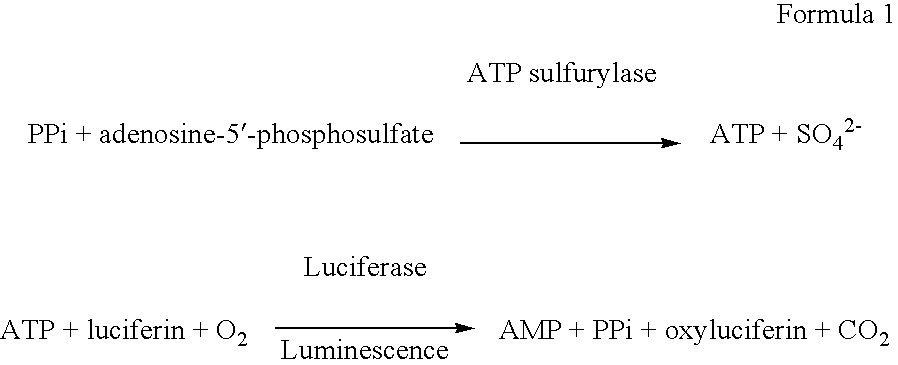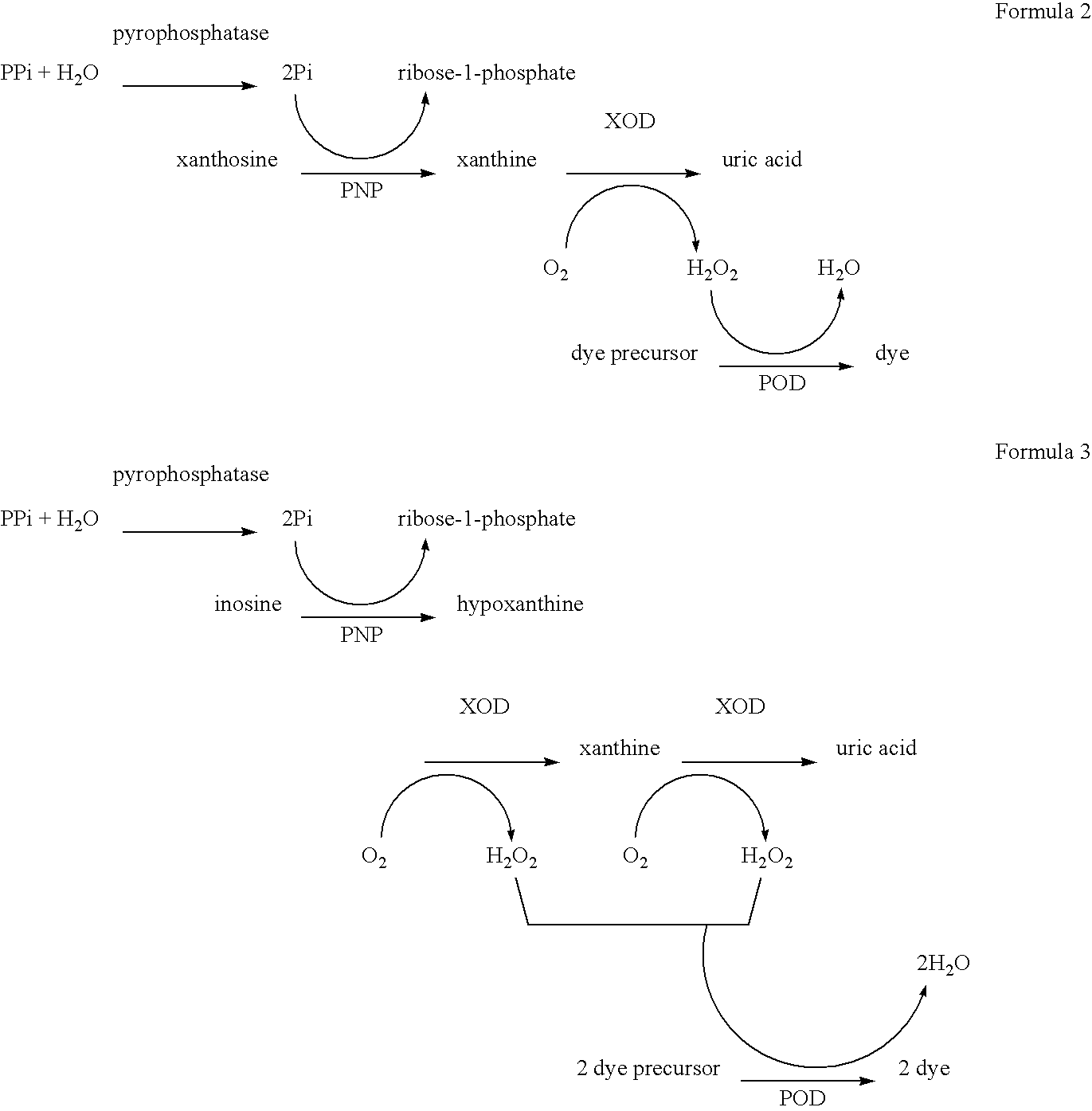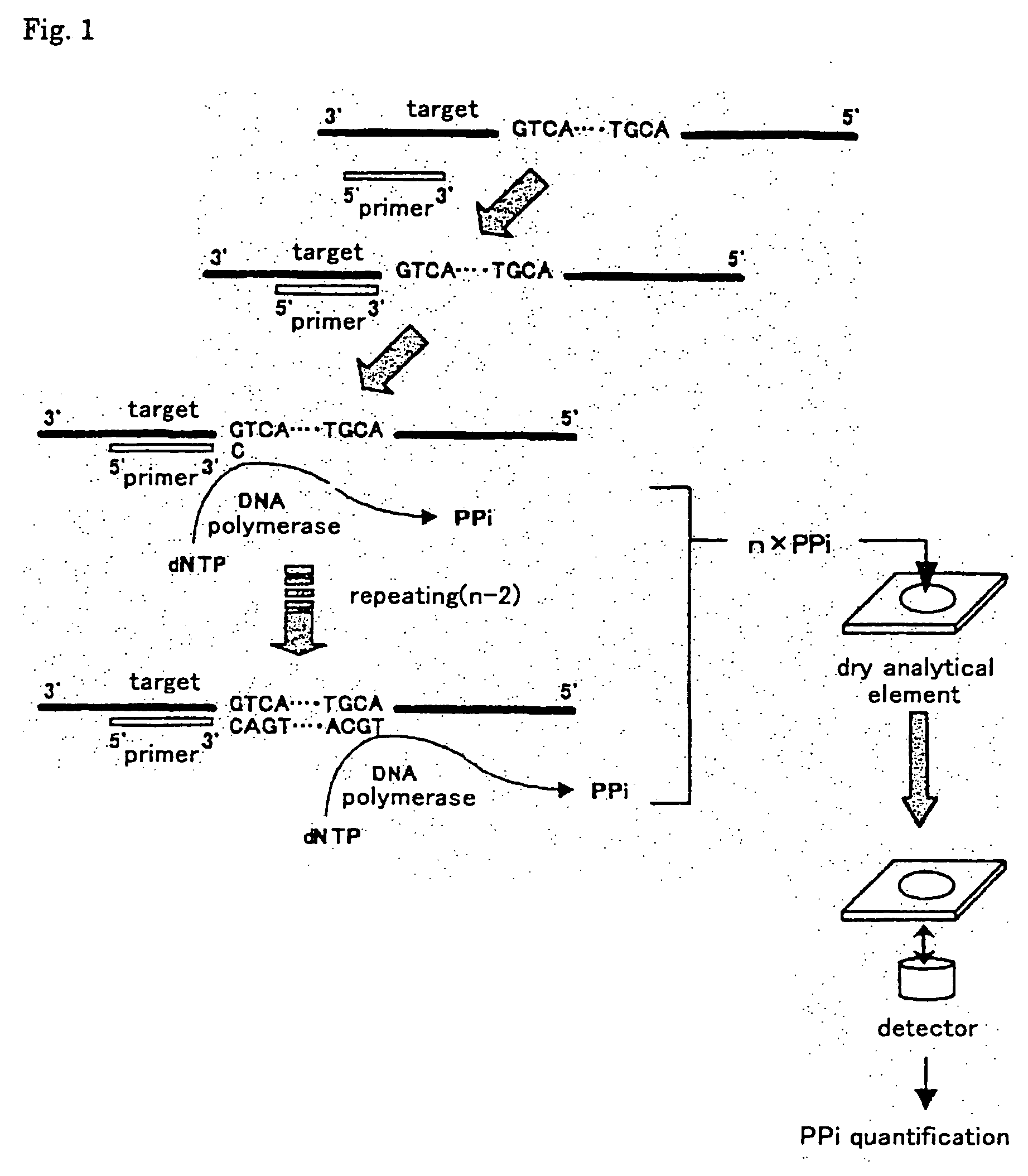Method for analyzing a target nucleic acid fragment and a kit for analyzing a target nucleic acid fragment
a nucleic acid fragment and kit technology, applied in the field of methods a kit for analyzing a target nucleic acid fragment, can solve the problems of long time-consuming and laborious, inability to always quickly, and inability to successfully carry out culturing, etc., to achieve simple and swift culturing, excellent convenience and quickness
- Summary
- Abstract
- Description
- Claims
- Application Information
AI Technical Summary
Benefits of technology
Problems solved by technology
Method used
Image
Examples
example 1
Detection of SRY Gene-Associated Site on the Short Arm of Y Chromosome Using Dry Analytical Element for Quantifying Pyrophosphoric Acid
(1) Preparation of Dry Analytical Element for Quantifying Pyrophosphoric Acid
[0095] An aqueous solution having composition (a) shown in Table 1 was coated at the following coverage on a colorless transparent polyethylene terephthalate (PE) smooth film sheet (support) having a gelatin undercoating layer (thickness of 180 μm). The coating was then dried to provide a reagent layer.
TABLE 1Composition (a) of aqueous solution for reagent layerGelatin18.8g / m2p-Nonylphenoxy polyxydol1.5g / m2(glycidol unit: containing 10 units on average)(C9H19—Ph—O—(CH2CH(OH)—CH2—O)10H)Xanthosine1.96g / m2Peroxidase15,000IU / m2Xanthine oxidase13,600IU / m2Purine nucleoside phosphorylase3,400IU / m2Pyrophosphatase15,000IU / m2Leuco dye0.28g / m2(2-(3,5-dimethoxy-4-hydroxydiphenyl)-4-phenethyl-5-(4-dimethylaminophenyl)imidazoleWater136g / m2(pH was adjusted to 6.8 with a diluted NaOH s...
example 2
Detection of Single Nucleotide Polymorphisms (SNPs) of Aldehyde Dehydrogenase Gene (ALDH2 gene)-Associated Site Using Dry Analytical Element for Quantifying Pyrophosphoric Acid
(1) Preparation of Sample Solution of Target Nucleic Acid Fragment
[0106] Based on each of the blood specimens collected from each of subjects, who are respectively known to be either in the active form of ALDH2 or inactive form of ALDH2 by nucleotide sequencing because of difference in a specific type of nucleotide in the ALDH2 gene-associated site, sample solutions of target nucleic acid fragment were prepared respectively as the sample active form of ALDH2 and the sample inactive form of ALDH2 in the same manner as described in (2) in Example 1.
(2) Design of Primer
[0107] A primer was synthesized as a set of oligonucleotide primers: an oligonucleotide primer (primer 1) having a nucleotide sequence designed as a primer specific to the ALDH2 active nucleotide sequence for a specific portion determining th...
example 3
Detection of SRY Gene-Associated Site on Short Arm of Y Chromosome Using Dry Analytical Element for Quantifying Inorganic Phosphorus
[0111] The reflection density (ORR) was measured in the same manner as described above, except that a dry analytical element for quantifying inorganic phosphorus was used which was prepared in the same manner as the preparation of the dry analytical element for quantifying pyrophosphoric acid shown in (1) in Example 1 except that pyroposphatase was removed from composition (a) of an aqueous solution for the reagent layer in Table 1, and that 100 μL of reaction solution after PCR was treated with 10 units of pyrophosphatase (pH 7.0, 37° C., 10 minutes). The results were 0.268, 1.268, and 0.273 respectively for the control sample M, and sample F.
[0112] Example 3 demonstrates that the existence of the target nucleic acid fragment can be specifically detected by the method according to the second embodiment of the present invention in which pyrophosphoric...
PUM
| Property | Measurement | Unit |
|---|---|---|
| thickness | aaaaa | aaaaa |
| thickness | aaaaa | aaaaa |
| thickness | aaaaa | aaaaa |
Abstract
Description
Claims
Application Information
 Login to View More
Login to View More - R&D
- Intellectual Property
- Life Sciences
- Materials
- Tech Scout
- Unparalleled Data Quality
- Higher Quality Content
- 60% Fewer Hallucinations
Browse by: Latest US Patents, China's latest patents, Technical Efficacy Thesaurus, Application Domain, Technology Topic, Popular Technical Reports.
© 2025 PatSnap. All rights reserved.Legal|Privacy policy|Modern Slavery Act Transparency Statement|Sitemap|About US| Contact US: help@patsnap.com



